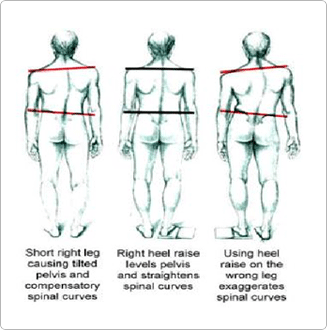I had this Leg Length Discrepancy since I was a toddler with chronic knee pain that would wake me from my sleep. The only relief was to run scolding hot water in the bathtub over my knee until I wouldn’t feel anything. I have been to all kinds of Dr.’s including going to Shriners in Chicago, also was prescribed a shoe insert which only helped my slight limp. Now in my 30’s the pain is still current but not as bad as when I was younger. My leg twitches/shakes especially when it’s cold outside, it also stiffness causing a bad limp. No doctor’s I have seen take it seriously, like you said, they just say it’s common and can’t be that painful which is B.S.., sorry this is so long but I feel like I found somebody which understands. As I gained weight my balance and strength in my right leg diminished, my knee(s) always cracks and I have constant pain. I’ve tried stretching, swimming, basketball and after playing my leg/ankles hurt so bad that I feel my heart beat as it pulsates and is difficult to walk. I would like to know what/which kind of doc to see and what kind of test’s to take from your opinion. Again I apologize for such a long novel I wrote but after decades it seems finally someone is listening. Please email me a response if you can, greatly appreciated God Bless.
Signed,
A European living in Chicago with a short leg
I am sorry to hear about your problems and frustrations. I am however well versed in this condition and have personally read and reviewed almost all scientific studies regarding leg length discrepancy. It is true that short legs are “common” and are found in roughly 75% of the human population……in fact most features in humans are not symmetrical. The point missed by many doctors is HOW MUCH the leg length difference is.
When our leg bones do not grow symmetrical excess stress occurs on one side of our body due to the leg length discrepency. This results in excess loading of joints and can lead to unnecessary pain. The shorter the leg is the more excess stress will be and potentially the more painful it can be. This process is accelerated when someone is active. Because they are on their feet more the excess stress is more regular and the pain is felt sooner or with more intensity.
One simple indicator that you have a leg length discrepancy is if one of your feet is larger than the other. If one foot is larger than the other you already know you are not symmetrical. Below are the proper tests to help determine your leg length discrepancy.
The proper tests to determine the bony difference in the case of a leg length discrepancy are to measure from the hip to the ankle with the patient lying on their back. The measurement should be taken 3x with care given to ensure the same bone landmarks are used as a reference point each time. The normal landmarks are to measure from the ASIS (Anterior Superior Iliac Spine) to the medial malleolus (the large bump on the inside of your ankle).
The second test is to put the person on dual scales and measure the weight distribution and record the difference. The person should be looking straight ahead with their eyes open, then eyes closed and a third recording again with eyes open. You can then take the average of the three recordings to get a decent reading of how much excess load is being placed on their painful side.
The third test is to get an x-ray with the patient lying down. Both femurs and tibias are x-rayed (it’s called a scannogram or CT scan). The radiologist will then record the exact length of each femur, tibia and knee joint space. Next they will compare the difference and subtract the short side from the long side and record the difference.
Once you have the true leg length discrepancy you can compare it to your physical measurements to figure out how much of the difference is due to muscular compensation. To correct the anatomical/bone difference a full length lift is made to correct roughly half of the actual difference and a stretching and strengthening program is constructed to address the muscular compensation.
As for what kind of Dr. you should see……..it would need to be a doctor that treats bones, muscles, joints etc usually referred to as an orthopedic. It could be a physical therapist or chiropractor as well. The main concern is that they care about you and your condition and are willing to try anything to help you. You will have difficulty finding someone that specializes in leg length discrepancy but now that you know what the proper tests are you can find someone that is willing to do the tests for you.
If you live in Chicago and have dealt with this for so long why not plan a trip, come to San Diego and let me help you? If you would like to do this please call my office at 858-268-8525. We have people fly in from around the county regularly. Considering the chronic and painful nature of your problem the cost would be minimal and it would save you years of needless pain, stress and depression.
If you require more information please email info@sdri.net or call 858-268-8525 to schedule an appointment.
If you want more information on Leg Length Discrepancy (LLD) click here
The medical information on this site is provided as an information resource only, and is not to be used or relied on for any diagnostic or treatment purposes. This information is not intended to be patient education, does not create any patient-physician relationship, and should not be used as a substitute for professional diagnosis and treatment.


Leave A Comment